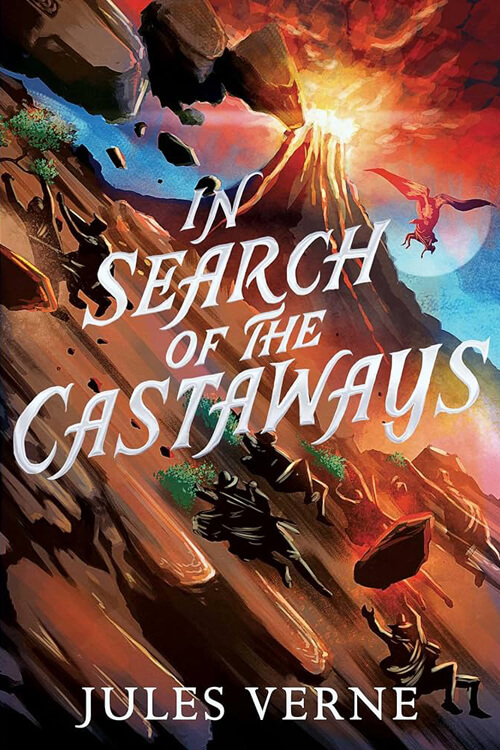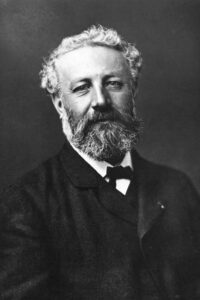
In Search of the Castaways
On the 26th of July, 1864, a magnificent yacht was steaming along the North Channel at full speed, with a strong breeze blowing from the N. E. The Union Jack was flying at the mizzen mast, and a blue standard bearing the initials E. G., embroidered in gold and surmounted by a ducal coronet, floated from the topgallant head of the main mast. The yacht’s name was the DUNCAN, and the owner was Lord Glenarvan, one of the sixteen Scotch peers who sit in the Upper House and the most distinguished member of the Royal Thames Yacht Club, so famous throughout the United Kingdom.
Lord Edward Glenarvan was on board with his young wife, Lady Helena, and one of his cousins, Major McNabbs.
The DUNCAN was newly built and had been making a trial trip a few miles outside the Firth of Clyde. She was returning to Glasgow, and the Isle of Arran already loomed in the distance when the sailor on watch caught sight of an enormous fish sporting in the wake of the ship. Lord Edward, who was immediately apprised of the fact, came up on the poop a few minutes after with his cousin and asked John Mangles, the captain, what sort of an animal he thought it was.
“Well, since your Lordship asks my opinion,” said Mangles, “I think it is a shark and a fine large one too.”
“A shark on these shores!”
“There is nothing improbable in that,” returned the captain. “This fish belongs to a species found in all latitudes and all seas. It is the ‘balance-fish,’ or hammer-headed shark, if I am not much mistaken. But if your Lordship
has no objections, it would give Lady Helena the smallest pleasure to see a novelty in fishing. We’ll soon haul up the monster and find out what it is.”
“What do you say, McNabbs? Shall we try to catch it?” asked Lord Glenarvan.
“If you like, it’s all one to me,” his cousin replied.
“The more of those terrible creatures that are killed, the better, at all events,” said John Mangles, “so let’s seize the chance, and it will not only give us a little diversion but also be a good action.”
“Very well, set to work, then,” said Glenarvan.
Lady Helena soon joined her husband on deck, quite charmed at the prospect of such an exciting sport. The sea was splendid, and every movement of the shark was distinctly visible. In obedience to the captain’s orders, the sailors threw a strong rope over the starboard side of the yacht, with a big hook at the end of it, concealed in a thick lump of bacon. The bait took at once, though the shark was full fifty yards distant. He began to make rapidly for the yacht, beating the waves violently with his fins and keeping his tail straight. As he got nearer, his great projecting eyes could be seen inflamed with greed, and his gaping jaws with their quadruple row of teeth. His head was large and shaped like a double hammer at the end of a handle. John Mangles was right. This was a balanced fish—the most voracious SQUALIDAE species.
The passengers and sailors on the yacht watched all the animal’s movements with the liveliest interest. He soon came within reach of the bait, turned over on his back to make a good dart at it, and in a second, bacon and contents had disappeared. He had hooked himself now, as the tremendous jerk he gave the cable proved, and the sailors began to haul in the monster using tackle attached to the main. He struggled desperately, but his captors were prepared for his violence and had a long rope ready with a slip knot, which caught his tail and rendered him powerless at once. In a few minutes more, he was hoisted up over the side of the yacht and thrown on the deck. A man came forward immediately, hatchet in hand, and approaching him cautiously, with one powerful stroke cut off his tail.
Read or download Book
Jules Verne
Jules Gabriel Verne (8 February 1828 – 24 March 1905) was a French novelist, poet, and playwright. His collaboration with the publisher Pierre-Jules Hetzel led to the creation of the Voyages Extraordinaires, a series of bestselling adventure novels including Journey to the Center of the Earth (1864), Twenty Thousand Leagues Under the Seas (1870), and Around the World in Eighty Days (1872). His novels, always well documented, are generally set in the second half of the 19th century, considering the technological advances of the time.
In addition to his novels, he wrote numerous plays, short stories, autobiographical accounts, poetry, songs, and scientific, artistic, and literary studies. His work has been adapted for film and television since the beginning of cinema and for comic books, theater, opera, music, and video games.
Verne is considered an essential author in France and most of Europe, where he has greatly influenced the literary avant-garde and surrealism. His reputation was markedly different in the Anglosphere, where he had often been labeled a writer of genre fiction or children’s books, mainly because of the highly abridged and altered translations in which his novels have frequently been printed. Since the 1980s, his literary reputation has improved.
Since 1979, Jules Verne has been the second most translated author in the world, ranking below Agatha Christie and above William Shakespeare. He has sometimes been called the “father of science fiction,” a title that has also been given to H. G. Wells and Hugo Gernsback. In the 2010s, he was the most translated French author in the world. In France, 2005 was declared “Jules Verne Year” on the occasion of the centenary of the writer’s death.
Life
Early life
Verne was born on 8 February 1828, on Île Feydeau, a then small artificial island on the river Loire within the town of Nantes (later filled-in and incorporated into the surrounding land area), in No. 4 Rue Olivier-de-Clisson, the house of his maternal grandmother Dame Sophie Marie Adélaïde Julienne Allotte de La Fuÿe (born Guillochet de La Perrière). His parents were Pierre Verne, an attorney originally from Provins, and Sophie Allotte de La Fuÿe, a Nantes woman from a local family of navigators and shipowners of distant Scottish descent. In 1829, the Verne family moved some hundred meters away to No. 2 Quai Jean-Bart, where Verne’s brother Paul was born the same year. Three sisters, Anne “Anna” (1836), Mathilde (1839), and Marie (1842) would follow.
In 1834, at six, Verne was sent to boarding school at 5 Place du Bouffay in Nantes. The teacher, Madame Sambin, was the widow of a naval captain who had disappeared some 30 years before. Madame Sambin often told the students that her husband was a shipwrecked castaway and that he would eventually return like Robinson Crusoe from his desert island paradise. The theme of the robinsonade would stay with Verne throughout his life and appear in many of his novels, some of which include The Mysterious Island (1874), Second Fatherland (1900), and The School for Robinsons (1882).
In 1836, Verne went on to École Saint‑Stanislas, a Catholic school suiting the pious religious tastes of his father. Verne quickly distinguished himself in mémoire (recitation from memory), geography, Greek, Latin, and singing. In the same year, 1836, Pierre Verne bought a vacation house at 29 Rue des Réformés in the village of Chantenay (now part of Nantes) on the Loire. In his brief memoir Souvenirs d’enfance et de jeunesse (Memories of Childhood and Youth, 1890), Verne recalled a deep fascination with the river and with the many merchant vessels navigating it. He also took vacations at Brains, in the house of his uncle Prudent Allotte, a retired shipowner who had gone around the world and served as mayor of Brains from 1828 to 1837. Verne took joy in playing interminable rounds of the Game of the Goose with his uncle, and both the game and his uncle’s name would be memorialized in two late novels (The Will of an Eccentric (1900) and Robur the Conqueror (1886), respectively).
Literary debut
Thanks to his visits to salons, Verne came into contact with Alexandre Dumas in 1849 through the mutual acquaintance of a celebrated chirologist of the time, the Chevalier d’Arpentigny. Verne became close friends with Dumas’ son, Alexandre Dumas Fils, and showed him a manuscript for a stage comedy, Les Pailles rompues (The Broken Straws). The two young men revised the play together. Through arrangements with his father, Dumas had it produced by the Opéra-National at the Théâtre Historique in Paris, opening on 12 June 1850.
In 1851, Verne met with a fellow writer from Nantes, Pierre-Michel-François Chevalier (known as “Pitre-Chevalier”), the editor-in-chief of the magazine Musée des familles (The Family Museum). Pitre-Chevalier was looking for articles about geography, history, science, and technology and was keen to ensure that the educational component would be accessible to large popular audiences using a straightforward prose style or an engaging fictional story. With his delight in diligent research, especially in geography, Verne was a natural for the job. Verne first offered him a short historical adventure story, The First Ships of the Mexican Navy, written in the style of James Fenimore Cooper, whose novels had deeply influenced him. Pitre-Chevalier published it in July 1851, and in the same year published a second short story by Verne, A Voyage in a Balloon (August 1851). With its combination of adventurous narrative, travel themes, and detailed historical research, Verne would later describe the latter as “the first indication of the line of novel that I was destined to follow.”
Dumas fils put Verne in contact with Jules Seveste, a stage director who had taken over the directorship of the Théâtre Historique and renamed it the Théâtre Lyrique. Seveste offered Verne the job of secretary of the theater with little or no salary attached. Verne accepted, using the opportunity to write and produce several comic operas in collaboration with Hignard and the prolific librettist Michel Carré. To celebrate his employment at the Théâtre Lyrique, Verne joined ten friends to find a bachelors’ dining club, the Onze-sans-femme (Eleven Bachelors).






